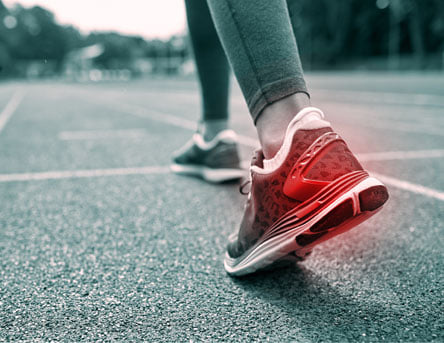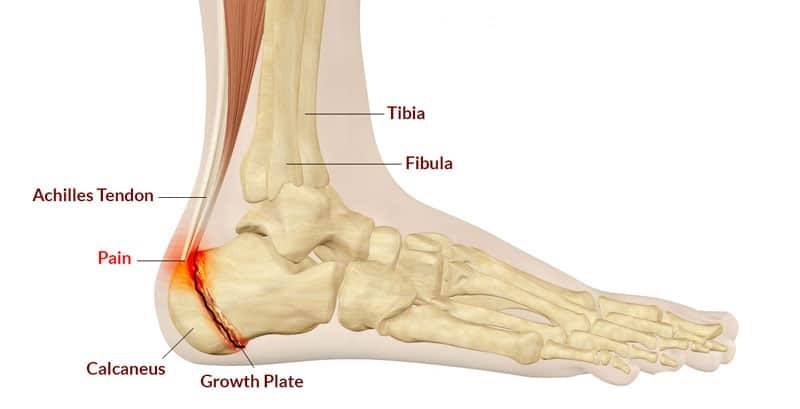Severs Disease

SEVER’S DISEASE/CALCANEAL APOPHYSITIS
Repetitive trauma and inflammation of the growth plates of the heel bone, due to traction of the Achilles tendon, can cause heel pain in children aged between 8 and 14 and this is known as Sever’s disease. It affects children of this age because the calcaneal apophysis, which is mostly cartilage develops at around 7 or 8 years old, not completing ossification until around 16 years old. Also this is when participation in sport, and therefore force through the joint increases, but the heel bone is still weaker than an adults, and so more prone to injury. Sever’s disease can occur in just one heel but around 60% of cases involve both feet.
The Achilles tendon inserts at the back of the heel bone, so the calcaneal growth plates are placed under stress from both the Achilles tendon and the plantar aponeurosis on the other side.
RISK FACTORS
• more common in boys, aged 10 – 15, who have later growth spurts. It usually occurs in girls aged 8 – 13, but never occurs after puberty
• overweight
• very active, particularly running and jumping on hard surfaces, eg football, basketball, or gymnastics
• unsupportive shoes for sport increase symptoms
• biomechanical abnormalities eg. flat feet, foot varus, high arches, bunions
CAUSES

• a growth discrepancy where the calf bone grows at a faster rate than the calf muscle and Achilles tendon, causing the soft tissues to tighten, which in turn places additional stress on the heel bone
• an altered foot position, eg pronation causes uneven weight distribution on the heel bone
• high activity level, particularly sports that involve running and jumping on hard surfaces eg. football, basketball, or gymnastics - this can increase stress on the soft tissues that are already tight
DIFFERENTIAL DIAGNOSIS
Other conditions that may cause posterior heel pain include:-
• Achilles Tendinopathy
• Haglund's Deformity
• Retrocalcaneal Bursitis
• Calcaneal stress Fracture
• Heel spur
• Heel pad syndrome
TESTS
• Passive dorsiflexion test of the ankle demonstrates limited dorsiflexion and pain
• Mediolateral compression of the calcaneal growth plate with positive pain response
• Gait analysis may indicate a limp or forceful heel strike
SYMPTOMS
• pain and inflammation in one or both heels and lower leg
• pain is usually better when the child gets up in the morning or after res
t• increased pain with weight bearing, running or jumping
• tenderness on medial and lateral heel compression
• a tender swelling or bulge on the heel that is sore to touch
• calf stiffness first thing in the morning
• the pain may be worse when wearing hard, stiff shoes like football boots
• walking or running with a limp or on tip toes
• may be other biomechanical abnormalities of the foot
• restricted ankle dorsiflexion due to tight Achilles tendon
TREATMENT
Sever’s disease will disappear following the growth spurt and will not cause any long-term problems. The best way to manage it is through rest and reducing spots activity
.• rest and reduction/cessation of sports
• ice to reduce swelling and pain
• nonsteroidal anti-inflammatories (NSAIDs), eg. ibuprofen or naproxen, or ketoprofen gel, to relieve the pain
• stretching to lengthen tight calf and hamstring muscles
• stretching of plantar fascia to improve dorsiflexion and strengthening of extensors
• gentle mobilization of the subtalar joint and forefoot area
• pacing yourself during sport while the injury is healing
• strapping during sports to reduce range of motion in the ankle
• ankle foot orthoses to prevent over pronation of the foot and improve shock absorption
• supportive shoes and a heel raise to reduce stress on the Achilles tendon, particularly if flat feet or high arches are an issue
• Physiotherapy – to reduce pain and swelling, relieve muscle tension and reduce stress on the Achilles tendon and calf muscle
• massage therapy
• In severe cases, casting will rest the heel
• Corticosteroid injections are not recommended
ASSESSMENT
• Observation of the client performing a squat will often present pronation and external rotation of the foot, sometimes with a shift in body weight to one side. This may also result in a pelvic tilt and/or hip problems
.• If casting has been done to rest the heel at any point, this immobilisation may have caused muscle weakness or compensatory measures in the fascia
.• Tight hamstrings or previous hamstring strain may present as difficulty in touching the toes
• a single leg lunge may show loss of core stabilization and potentially the knee on the back leg may cave in
• symptoms will usually occur as a chain of events, starting with reduced mobility in the foot and ankle, which can then lead to hamstring compensation, lack of core control, and often these factors will encourage TFL problems and hip pain.
MASSAGE BENEFITS
• will increase blood and lymphatic circulation to the calf muscles and Achilles tendon, removing waste and improving oxygen supply to aid recovery
• release tension in calf muscles, easing the pressure pulling on the heel, and also compensating muscles such as the hamstrings and glutes
• gentle stretching can be introduced once tension has been released, being careful not to overstretch the calf, and increase heel tension
PREVENTION
Sever’s disease will only be an issue while growth spurts are still happening, but the following measures may help reduce symptoms:-
• stretch the calves and hamstrings
• avoid lots of running and pounding on hard surfaces
• avoid over-training, and take sufficient rest periods, particularly when the heel becomes painful
• wear supportive, shock-absorbing shoes
• if overweight, losing some can help relieve pressure on the heels
